Busworld SouthEast Asia 2019 made an impressive debut in Jakarta, Indonesia.
Story and Photos by
Ashish Bhatia
Busworld SouthEast Asia 2019 made an impressive debut at the Jakarta International Expo (JIEXPO) in March 24-26, 2019. As the first bus and coach only expo in the country, the fair managed to attract a large number of stakeholders to participate. With 100 per cent occupancy, the show saw close to 6,900 visitors descend on the JIEXPO’s 10,000 sq.m. hall to check out the advances made in the domain of bus and coach design. Visitors also could witness advances made in components and after sale services. Succeeding in drawing attention to the huge potential for bus and coach manufacturers, and ancillaries, the inaugural edition underlined the need for the global mobility community to cater to unique demands against a backdrop of an ageing bus fleet and the growing clout for ‘coach tourism’. Through the course of the three-day exhibition, stakeholders of the bus and coach industry in Indonesia stressed on an efficient mass public transport mechanism to address many challenges faced by the people during their travel. Averred Didier Ramoudt, President of Busworld International, in his inaugural speech, that every country of any significance has a similar set of problems. He gave an example of how other markets in the world are coping up with rapid urbanisation and referred to the rapid urbanisation taking place in Indonesia. “The answer to tackle ‘traffic jams’ as it is called here in Indonesia requires governments to fall back on an efficient mass public transportation mechanism fed by buses and coaches,” he mentioned. “While we respect the culture of each market, at times it is necessary to break some rules in order to get the house back in order,” he quipped. Referring to the exploding two-wheeler population in the country, Ramoudt said that new ways need to be found to address rising congestion.
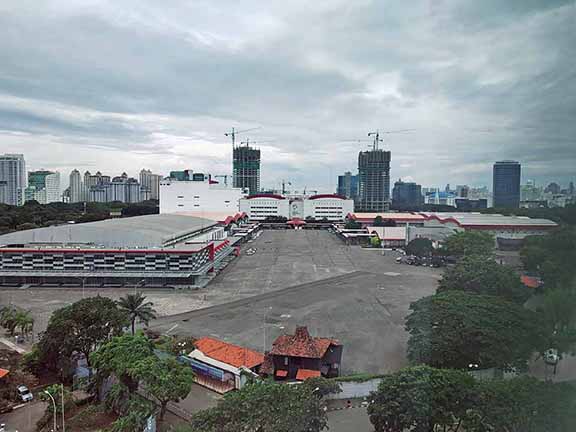
With two-wheelers looked upon as the key contributor to the country’s congestion woes with no signs of an immediate roll-back, Ramoudt opined, “There is a need to incentivise public transportation. Affordability can draw people towards it.” Responded Jan Deman, Director at Busworld Academy, that to arrest the decline of transport market for bus services, there is a need to better utilise the available fleet. “Bus operators need to become economically more rational,” he stated. Emphasising on attaining a higher degree of digitalisation pertaining to fleet management, Deman suggested that there is a need for capacity growth by way of articulated buses in metropolitan cities. Many visitors at the show could witness the affinity of the people of Indonesia (With a population of 260 million approximately, and accounting for nearly 40 per cent of the ASEAN population) towards buses, the inaugural edition of the fair attracted public and private participation in terms of the industry stakeholders. H. E. Stephane De Loecker, the Belgian Ambassador touched upon the transformation in Jakarta. Jakarta has transformed over the last seven years, she emphasised in her speech. Infrastructural developments like TransJakarta Bus Rapid Transit (BRT) system and the new Mass Rapid Transit (MRT) system will improve connectivity, she averred. Of the opinion that buses and coaches were sustainable as a means to attain zero emission levels in the near future, Loecker mentioned, “The country is estimated to add over 200,000 new buses.” Oozing with optimism, the fair saw stakeholders striving to address the need gaps.
Among the key bus and coach manufacturers who participated in the event, included Volvo Buses and PT Daimler Commercial Vehicles Indonesia. While OEMs made their presence felt, bodybuilders were not far behind. Reckoned as a bus bodybuilder market primarily, the expo saw a good number of ancillaries participate too. Comprising of 600 bodybuilders, big, medium and small in size, Indonesia, according to Sommy Lumadjeng, Chairman, Askarindo, has a huge potential to realise its export aspirations if the government provides good support to the country’s bus bodybuilding industry. “Bodybuilders in Indonesia not only import components but export end products to all countries of the world that match our quality and technology,” he informed. Representing the bodybuilders in Indonesia were companies like Laksana and New Armada at the show. They engaged eyeballs with their contemporary buses and coaches. These were fitted in accordance with benchmarks set by the OEMs on their chassis. In the area of ancillaries, companies like Voith, Allison, ZF, and DAFO participated. They have been leveraging their global product portfolio to align with the SouthEast Asia market needs. Testing the waters, the exhibition saw many companies participate for the first time.
On the sidelines of the exhibition, the Busworld Academy held conferences to signal the market trends. The conferences also covered a broad spectrum of topics. Attracting 350 delegates and four international partners — UNCRD, UN-HABITAT, UCLG-ASPAC and UITP, the fair also saw the holding of a CEO conclave, which touched upon the role of Bus Rapid Transport (BRT) system in mass transport integration. The Jakarta enhancement of bus ridership through integration and connectivity, futuristic transportation solutions besides PT alternatives were also discussed. Attracting the international press, the TransJakarta tour conducted by the Institute for Transportation and Development Policy (ITDP) provided a good insight into the country’s Bus Rapid Transport (BRT) System. The one at Jakarta is claimed to be the world’s longest BRT system spanning a corridor length of 251 km. It is estimated to serve 663,000 passengers on a daily average, and is said to be looking at electrifying its fleet. Apart from global players like Volvo and Daimler, electric bus manufacturers like BYD and the Jakarta-based Mobil Anak Bangsa (MAB) made their presence felt at the expo.
Proving to be a platform for the official ‘Jakarta Declaration’, which was drawn up and adopted by all the partners, the conference, ‘Making Bus Transport Systems Attractive, Efficient and Affordable in Southeast Asia’, turned out to be quite interesting. Delving upon the declaration, the conference saw panelists discuss about promoting bus transport and moving towards zero emission. The panelists also discussed issues like safety, comfort, accessibility and affordability. Mentioned Ramoudt, that the market in Indonesia has waited for long to have a bus only exhibition. He called upon the stakeholders of the Indonesian bus and coach industry to make the next edition (2021) of the show double in size. Revealed Baki Lee, President Director of GEM Indonesia, and co-organising partner of Busworld SouthEast Asia 2019, “The focus of the next edition will be much more on electric buses.”
Volvo Buses
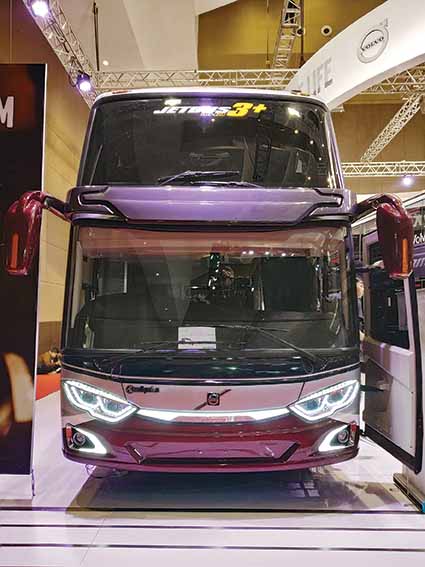
After a prolonged gap of 10 years, Volvo Buses via its importer Wahana Inti Selaras made a grand appearance at Busworld SouthEast Asia 2019. The company launched a premium bus range in the form of Volvo B8R and Volvo B11R. Marking Volvo’s re-entry in the Indonesian market, the two buses drew a crowd. Announcing that they are extremely excited to introduce them, Akash Passey, Senior Vice President, Business Region International, mentioned, “These buses have proven their performance with demanding customers in several countries and are sure to also meet the requirements of the Indonesian bus market.” Showcasing the Volvo B11R chassis in the guise of an ultra-high coach and a double-decker coach, Volvo displayed its might with a claim of providing just the right solutions. Termed the ‘maxi-bus’ in Indonesia, the B11R buses are capable of accommodating 90 passengers.
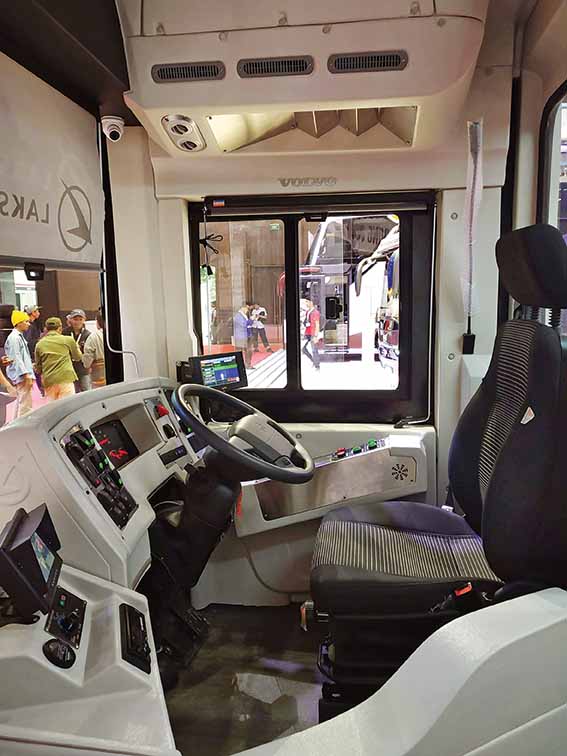
Powered by a 430 hp (the highest for a bus in Indonesia) 11-litre, six-cylinder, inline EuroIII engine, the B11R is equipped with a 12-speed I-shift transmission. It features a kneeling system (standard), disc brakes on all wheels, EBS, ABS and ESP. The Volvo B8RLE 4×2 low-entry city bus model is powered by a 330 hp eight-litre, six-cylinder, in-line EuroIII engine mated to the six-speed Automatic ZF 6AP 1200C series transmission. Features of the bus include a kneeling system (standard), disc brakes on all wheels, EBS, ABS and a built-in hydraulic retarder. Setting up an after sales network of 74 dealerships with an assured 24×7 service availability and spare parts to back the new products, Volvo Buses, in Indonesia is confident of delivering on its promises through PT Indotruck Utama. PT Indotruck Utama has been Volvo’s reliable business partner for 35 years, and is known to offer reliable and high-quality range of product in the Volvo Construction Equipment and Volvo Trucks domain.
At the Busworld exhibition, Bambang Prijono, President Director, PT Indotruck Utama, announced that the company became the official partner for Volvo Buses with effect from 2018. Entering the Indonesian bus market in the early 1980s, with the 320 double-decker city buses sold under the Ministry of Transport acquisition program from 1981 to 1984, Volvo Buses had its first stint in Indonesia. In 2017, the Swedish bus maker, in a landmark deal delivered 119 Volvo B11Rs to the TransJakarta Busway BRT system.
PT Daimler Commercial Vehicles

PT Daimler Commercial Vehicles Indonesia (DCVI) introduced the Mercedes-Benz OF 917 at the Busworld SouthEast Asia 2019. A segment leader in intercity buses, the Mercedes-Benz OF 917 marks many improvements. A front-engine chassis, it has grown in width; has full pneumatic brakes, ergonomic driving position, and is available in two seating options. Powered by a 170 hp 3.9 litres, EuroIII diesel engine ( 4D34i) mated to a MO36S6 six-speed manual transmission, the OF 917 could be also had with a six-speed Allison T 2100 automatic transmission.
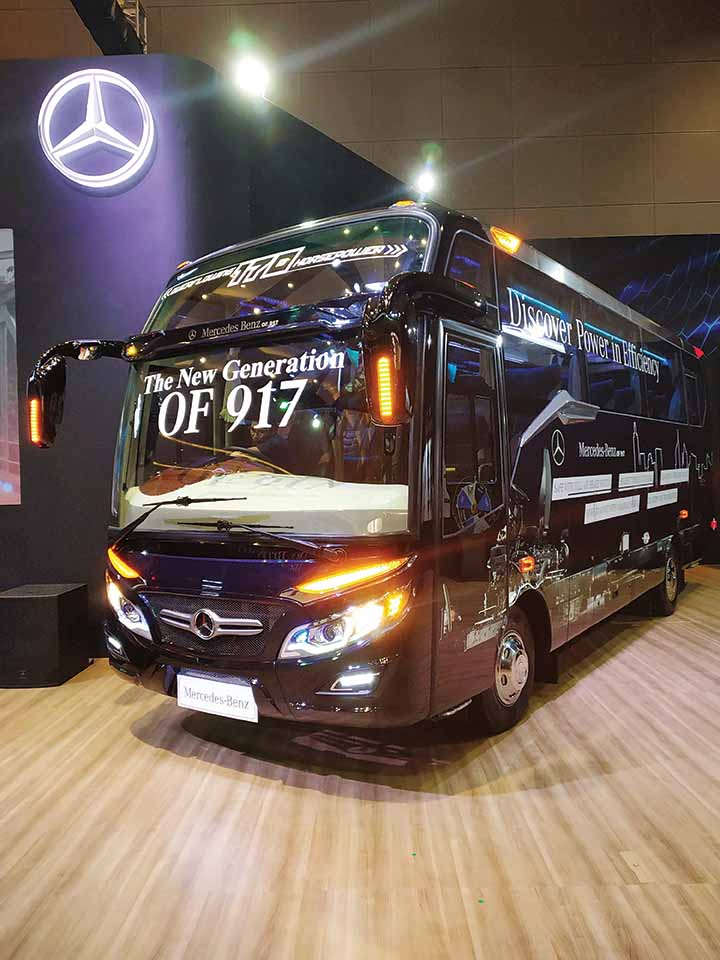
The Mercedes-Benz OF 1623, O500RS 1836 and OC500RF 2542 marked yet another display of premium buses by Daimler at the show. Of the three, the OF 1623 is a front-engine intercity bus. The 0500 RS 1836 is a rear-engine bus chassis whereas the OC500RF 2542 is a rear-engine tour coach. Said Christopher Stemmer, Vice President of Sales, Marketing and CSP Mercedes-Benz Commercial Vehicles – SEA, “As the only premium brand with strong legacy and experience in developing cars, vans, buses and trucks, Mercedes-Benz has been devoting its resources to set new benchmarks for answering the needs of our passengers and customers.” “With the advancement of Indonesia road infrastructure, Mercedes-Benz buses can go beyond a mere transportation tool to become a solution of connectivity and people’s mobility,” he mentioned.
Said to be in the process of expanding its dealership network and introducing ‘FleetBoard’ comprehensive fleet management system, the DCVI, in 2018, added five new dealerships in select cities outside Java Island such as Sulawesi and Kalimantan, taking the total number of dealerships to 17. Established in 2018 as a subsidiary of Daimler AG, DCVI is represented by PT Mercedes-Benz Indonesia as the manufacturing company for Mercedes-Benz Commercial Vehicles. DCVI is the distribution company.
PT. Transjakarta
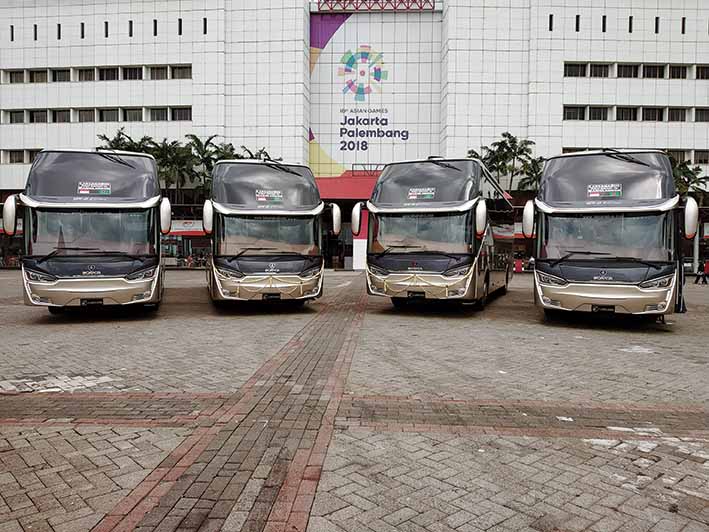
PT. Transjakarta is looking at electrification of its fleet. A state-owned public transportation company, it is on a mission to provide mobility and address traffic congestion. Keen to transform into a sustainable world-class public transportation company that contributes positively to shareholders and stakeholders, PT. Transjakarta operates 13 BRT routes, and showcased a BYD k9 electric bus, and a locally made MAB MD12E bus. The two will run as part of the Kalpatrans fleet on a six-month trial basis very soon. The k9 BYD e-bus, according to a study conducted by the company, consumes 1.30 kWh per kilometre, and costs USD 0.1 per kWh. Used over a 10 year period, it is estimated to return a mileage of 1,095,000 kilometres, which translates to a per kilometre cost of USD 142,350 resulting in a cumulative saving of USD 185,055, effectively translating into a fuel saving of 511,365 litres and a CO2 saving of 1,176,139.5 kilograms equivalent to a plantation of 653 trees. Powered by a Lithium Ferro Phosphate battery (LiFePO4) of 259 kWh capacity, the 12 m e-bus churns out 268 horsepower at 1200 rpm and a peak torque of 2400 Nm at 3000 rpm. Taking three hours for a complete recharge, it features power sliding doors, EPS, ABS, EBD and stability control. Seating up to 28 passengers exclusive of standees and inclusive of four priority seats that can be folded to make room for wheelchair passengers, the k9 BYD e-bus, along with the MAB MD12E are expected to support modernisation of Indonesia’s mass public transport fleet.
The PT. Mobil Anak Bangsa (MAB) e-bus is a low-floor concept with a 250 mm ground clearance. It is aimed at BRT and airport operations, and measures 12 metre in length. On a full charge, it is claimed to do 250 kilometres, and is powered by a HYQ 800-1200 type electric motor that is claimed to develop a power of 200 kW (268 hp) and a peak torque of 2400 Nm. The bus uses the LiFeP04 battery.

With the BYD k9 and MAB MD12E ebuses expected to be deployed on a six-month trial phase on the Jl. Sudirman-Thamrin route, and also to be deployed on the Gatot Subroto-MT Haryono or Gatot Subroto-Rasuna route, PT. Transjakarta has signed a memorandum of understanding with four companies to produce environmentally friendly electric buses. These include Taiwan’s RAC Electric Vehicles, Danish engineering company Danfoss and the Bandung Institute of Technology. At the expo, the company also created an awareness of ‘Jak Lingko’, the erstwhile OK-Otrip program which is about the integration of public transportation in Jakarta.
CV. Laksana
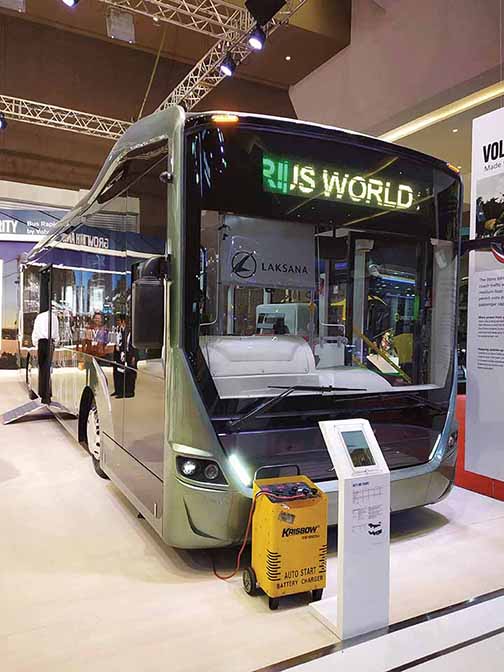
Indonesia based coach builder CV. Laksana (Laksana) introduced the all new Legacy Sky SR2 XHD Prime coach built on a Scania chassis. It’s aimed at sightseeing and long distance trips at Busworld. Attracting a whole lot of attention with its imposing stance, the bus measures 12.8 metres in length, 2.5 metres in width and 3.8 metres in height. Had in a semi-monocoque (option) variant too, the front fascia of the bus looks modern with the SR-2 new handlamp, a middle lamp ornament, DRLs and a chrome finish bumper ornament. The premium coach makes use of generous aluminium extrusion glass ornament on the sides. At the rear, the bus flaunts a new set of rear lamps with an aluminium steel air ventilation unit. Upon entering the driver compartment signals good ergonomics. Using MB tech and the ABS plastic to good effect, the bus employs PVC Vinyl flooring. Providing a premium feel, it has Laksana Versa seats. The coach is capable of seating 59 passengers. Featuring a compact toilet, the coach extends a spacious passenger gangway and a pleasant ambience. Equipped with an entertainment system and an Advance Lega lighting system with a four-theme control colour capability, the bus deploys an emergency exit roof hatch, emergency exit door, safety hammer to break the glass in an emergency, a fire extinguisher and a first aid kit. Built on a two-axle Scania K 410 hp (2,000 Nm) chassis, the transmission is a GR875R, eight-speed Scania Opticruise unit with kick-down and oil cooling. Featuring Electronic Braking System (EBS), Electronic Stability Programme (ESP), Scania retarder and Traction Control (TC) as standard features, the coach is termed as versatile. Apart from the Legacy Sky SR2 XHD Prime tour coach, the company also displayed the all new Legacy SR2 Transporter coach built on a Mercedes chassis. The latter’s major draw is its luggage compartment, which can hold two-wheelers parked in an upright position. The design, explained a Laksana representative, will address the SouthEast Asia market’s affinity to travel long-distances on coaches with their two-wheelers.
The company invited Retno Lestari, Minister of Foreign Affairs, and H.E. Major General Azmal Kabir, the Ambassador for Bangladesh in Indonesia, to inaugurate four brand new Laksana SR2 XHD Prime Legacy coaches, to be exported to Bangladesh for the first time ever. Laksana has signed up for the after sales, maintenance and repair period of ten years for the coaches. They will be operated by ENA Transport in Bangladesh. The four SR2 Legacy coaches will be followed by 10 Laksana SR2 double decker coaches. The latter will be built on Scania’s K 410 EB 6×2 chassis which also delivers 410 hp with a maximum torque of 2000 Nm at 1,000 to 1,350 rpm. Besides Fiji where Laksana has an export presence, the company aims to export to countries like Sri Lanka and Middle East. According to Alvin Arman, Commercial Director at CV. Laksana, the company’s coach-building journey can be traced back to Semarang around 1967. The company focused on automotive machinery, then. Experiencing good growth within the first three years of its existence, it started out in 1977 with Mitsubishi T-120 minivans on the back of an expanded auto-manufacturing division. The next step involved bus building.
Mekar Armada Jaya, Pt. (New Armada)
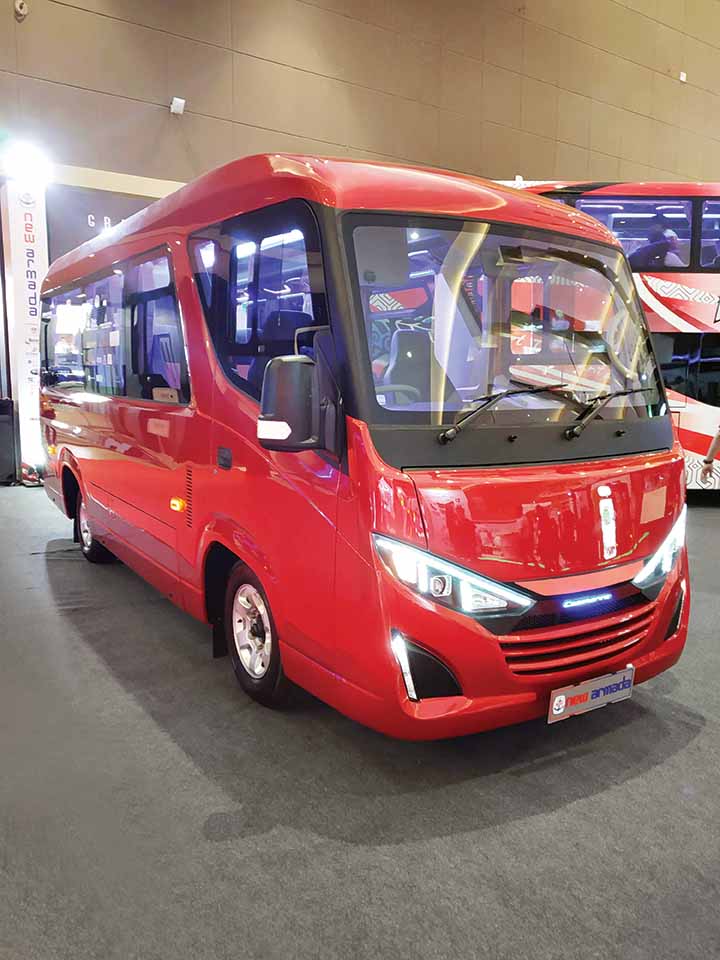
Bodybuilder New Armada showcased the Coasterina minibus at Busworld. Presented as a new face for minibuses, Coasterina is a people mover built as an attempt to bring together luxury and comfort in the form of a modern and safe product. Measuring 6.2 m in length, 1.85 m in width and 2.64 m in height, the 17 seater sporty bus with a 3.35 m wheelbase is built on Mitsubishi FE 71 BC NC chassis. The minibus can also be had on an Isuzu NLR 71 and Hino Dutro 110 SDBL chassis depending on customer requirement. The use of fibreglass in the front and rear cowl, steel sheet panelling on the side, and the aerodynamically designed top roof give the minibus a distinct look. The use of fibreglass is extended from the exterior to the interiors. The interiors make extensive use of wood panels. For the flooring, New Armada opted for Vynil. ABS vacuum forming makes up the door trims. The standard Coasterina audio system and 22 inches LED monitor constitutes the onboard entertainment system. A safety hammer, first aid kit and a fire extinguisher add to the safety features of the minibus.
New Armada also drew a lot of visitors to its stall courtesy the new double-decker coach named Skylander. A next generation double-decker coach, the Skylander succeeds New Armada’s Evolander and Highlander coach range. The coach can seat up to 32 passengers with an additional six VIP seats. Built on a Scania K410 IB 6×2 chassis, the coach can also be had on a Volvo B11R 370 6×2 chassis and the Mercedes-Benz 04500 RF 25Y2 6×2 chassis with pneumatic suspension and opticruise transmission. The sub-14-metre coach (13.5 m) measures 2.5 m in width and 4.015 m in height. The coach appears long with a 6 m long wheelbase. It’s front cowl features a stylish headlamp coupled with a new set of DRLs. The centre grill ornament and seamless triple glass gives the coach a distinct identity. Walk past the new side garnish over to the rear and the coach features a new tail lamp unit with an air ventilation unit (with floating blade). The top of the coach makes use of an aerodynamic glass design to cut down on the wind resistance. In the driver cabin, the dashboard uses wood panelling to good effect with ABS cover. The headlines make use of Full ABS forming with an aluminium profile skeleton. Like the Coasterina, flooring is of Vinyl type in the Skylander. The coach can be had with two – sleeper cabins (optional). New Armada was established in 1974, with Headquarter and manufacturing facility located in Magelang city, in the Central Java Province. The company rapidly grew on the back of continuous expansion of the manufacturing capabilities. By 1991 New Armada manufacturing area in Magelang had reached an expanse of 350.000 sq. m. By 2005 the company obtained ISO 9001, ISO 14001 in 2010, and an updated ISO 9001:2015 rating in 2017. The company’s products are said to have been well received by customers from both the domestic and international markets including countries like Macau, Vietnam,
Malaysia, South Africa, Bangladesh, Kenya, and Nigeria.
Voith Turbo, Pt. (Voith)

Looking at Indonesia as a potential market, European powertrain solutions major Voith, at Busworld committed to a presence in the SouthEast Asian market, in a bid to remain closer to its OE customers. With a renewed focus of Voith’s OE customerslike Volvo Buses and Daimler Commercial Vehicles Indonesia, Voith wants to partner them for growth. For instance, aiming at the intercity bus segment, the company displayed the VR 115 CT, a step-up gear retarder application claimed to offer a high braking torque. The VR 115 CT, a self-contained oil supply system that is integrated into the vehicle’s braking management system. In conjunction with the service brakes, it is said to offer optimal braking action and greater riding comfort. The v-constant function keeps the speed constant downhill similar to the downhill cruise control sans the need to use service brakes. The company also displayed the German made DIWA automatic transmission series compatible with Indonesia’s EuroIII standards for city buses. With 50 per cent less shifting and reduced downtime, and lower maintenance costs, DIWA offers optimised fuel-efficiency, lower air and noise pollution, true stop-start technology. Founded in 1867, Voith today has more than 19,000 employees,
with a cumulative sales of Euro 2 billion and a presence in over 60 countries worldwide as one of the largest family-owned companies in Europe.



















